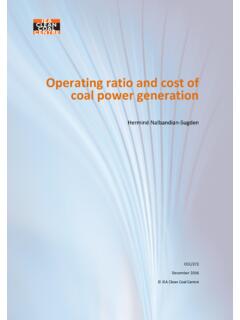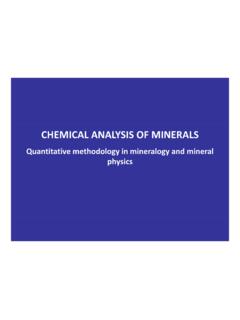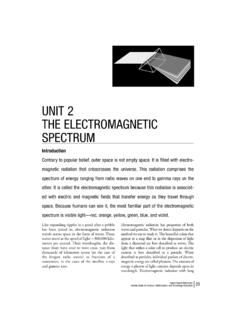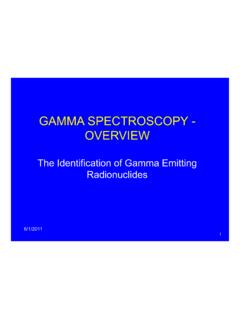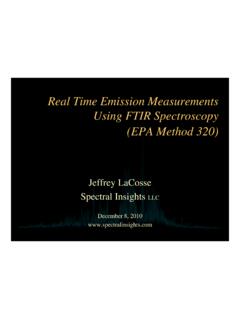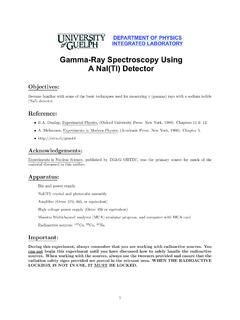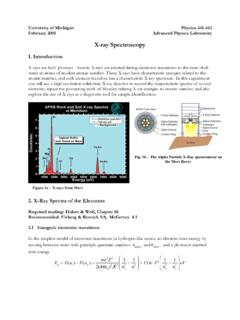Transcription of Coal Sampling and Analysis Standards
1 Coal Sampling and Analysis Standards Qian Zhu April 2014 IEA Clean Coal Centre Coal Sampling and Analysis Standards Author: Qian Zhu IEACCC Ref: CCC/235 ISBN 978 92 9029 555 6 Copyright: IEA Clean Coal Centre Published Date: April 2014 IEA Clean Coal Centre Park House 14 Northfields London SW18 1DD United Kingdom Telephone: +44(0)20 8877 6280 IEA Clean Coal Centre Coal Sampling and Analysis Standards 2 Preface This report has been produced by IEA Clean Coal Centre and is based on a survey and Analysis of published literature, and on information gathered in discussions with interested organisations and individuals.
2 Their assistance is gratefully acknowledged. It should be understood that the views expressed in this report are our own, and are not necessarily shared by those who supplied the information, nor by our member countries. IEA Clean Coal Centre is an organisation set up under the auspices of the International Energy Agency (IEA) which was itself founded in 1974 by member countries of the Organisation for Economic Co- operation and Development (OECD). The purpose of the IEA is to explore means by which countries interested in minimising their dependence on imported oil can co- operate.
3 In the field of Research, Development and Demonstration over fifty individual projects have been established in partnership between member countries of the IEA. IEA Clean Coal Centre began in 1975 and has contracting parties and sponsors from: Australia, Austria, Canada, China, the European Commission, Germany, India, Italy, Japan, New Zealand, Russia, South Africa, Thailand, the UK and the USA. The Service provides information and assessments on all aspects of coal from supply and transport, through markets and end- use technologies, to environmental issues and waste utilisation.
4 Neither IEA Clean Coal Centre nor any of its employees nor any supporting country or organisation, nor any employee or contractor of IEA Clean Coal Centre, makes any warranty, expressed or implied, or assumes any legal liability or responsibility for the accuracy, completeness or usefulness of any information, apparatus, product or process disclosed, or represents that its use would not infringe privately- owned rights. IEA Clean Coal Centre Coal Sampling and Analysis Standards 3 Abstract Each year, billions of tonnes of coal are traded in regional and international market for use in power generation, steel and cement making, and many other purposes.
5 In commercial operations, the price of coal not only reflects the quantity of coal but also reflects the relationship of a desirable property or a combination of properties to performance of the coal under service conditions. The properties of coal often form the basis of sale contracts, and payment for the coal is based on the analytical results. Coal is a very heterogeneous material containing various organic matter and inorganic (mineral) matter, and exhibits a wide range of physical properties. The Analysis of coal is generally performed on the coal samples taken from the bulk material and not from the individual components.
6 Given the extreme complexity of coal, coal Sampling protocols must provide material that is representative of the lot sampled. To ensure a representative sample is collected, correct Sampling procedures should be followed and certain rules adhered to. Also, analyses of coal need to be sufficiently accurate so as to preclude negative scientific or economic consequences. All coal analyses should follow standard procedures in order to obtain repeatable and reproducible results. This report reviews various aspects of coal Sampling and Analysis . It provides descriptions of standard procedures for coal Sampling , preparation and routine tests of coal specified in the international Standards .
7 The commonly used instrumental techniques for routine coal Analysis and their recent developments are also reviewed in this report. IEA Clean Coal Centre Coal Sampling and Analysis Standards 4 Acronyms and abbreviations ad air dry AAS atomic absorption spectroscopy AES atomic emission spectroscopy AFS atomic fluorescence spectroscopy ar as- received ASTM American Society for Testing and Materials Btu/lb British thermal units per pound cal/g calories per gramme CCSEM computer- contolled scanning electron microscopy cm centimetre CV calorific value CVAAS cold- vapour atomic absorption spectroscopy daf dry, ash- free dmmf dry.
8 Mineral- matter- free DUET dual- energy - ray transmission EDS energy dispersive x- ray spectrometer EMPA electron micro probe analyser EPM electron probe microanalysis FAAS flame atomic absorption spectroscopy FTIR Fourier transform infrared spectroscopy g gramme GFAAS graphite- furnace atomic absorption spectroscopy HT heating value HHV higher heating value IC ion chromatography ICP- AES inductively coupled plasma- atomic emission spectroscopy ICP- MS inductively coupled plasma- mass spectroscopy in inches INAA instrumental neutron activation Analysis ISO International Organisation for Standardisation J/g joules per gramme kcal/g kilocalories per gramme kcal/kg kilocalories per kilogramme kg kilogramme kJ/g kilojoules per gramme LHT lower heating value MAS magic angle spinning MJ/kg megajoules per kilogramme MJ/t megajoules per tonne ml/min millilitres per minute mm millimetre MR Magnetic Resonance MS mass spectrometry m micrometer MS M ssbauer spectroscopy m/s metres per second MW megawatts IEA Clean Coal Centre Coal Sampling and Analysis Standards 5 NAA neutron activation Analysis ng/g nanograms per gramme nm nanometre PFTNA prompt- fast
9 Thermal neutron Analysis PGAA prompt- gamma neutron activation Analysis PIXE proton- induced x- ray emission Analysis PLC programmable logic controller rpm revolutions per minute SAXS small angle x- ray scattering SEM scanning electron microscopy t/h tonnes per hour vol% volume percentage wt% percentage by weight XAFS x- ray absorption fine structure XANES x- ray absorption near edge structure XRD x- ray diffraction XRF x- ray fluorescence spectroscopy IEA Clean Coal Centre Coal Sampling and Analysis Standards 6 Contents Preface 3 Abstract 4 Acronyms and abbreviations 5 Contents 7 List of Figures 9 List of Tables 10 1 Introduction 11 2 International and national Standards 14 ISO Standards 14 ASTM International 14 British Standards 15 Chinese coal Standards 15 Indian Standards 16 South African national Standards 17 Australian Standards 17 3 Coal Sampling and sample preparation 18 Sampling 18 General principles of Sampling 19 Establishing a Sampling scheme 19 Precision of Sampling 20 Methods of Sampling 23 Sampling from moving streams 24 Sampling from stationary coal 26 Manual Sampling 29 Advances in mechanical Sampling systems 31 Automatic
10 Sampling systems 31 Collecting the full cross section 32 The Sampling system crusher 34 Command and control 36 Access to the Sampling systems 37 Sample preparation 38 Constitution of a sample 38 Air drying 39 Sample reduction 40 Sample division 40 Sample mixing 45 General rules of sample preparation 45 Bias testing 46 Sampling error 46 Methods of testing for bias 46 Comments 48 4 Standard laboratory Analysis of coal 49 Proximate Analysis 49 Moisture 49 Ash 51 Volatile matter 52 Fixed carbon 53 Ultimate Analysis 53 Carbon and hydrogen 53 Nitrogen 54 Sulphur 55 Calorific value 57 Ash Analysis 58 IEA Clean Coal Centre Coal Sampling and Analysis Standards 7 Preparation of coal ash 58 Major and minor elements 59 Trace elements 61 Miscellaneous Analysis 64 Chlorine 64 Mercury 65 Mineral matter in coal 66 Ash fusibility 66 Coal swelling property 68 Hardgrove Grindability index 70 Accuracy and precision 70 5 Instrumental analytical techniques 72 X- ray spectroscopy 72 X- ray diffraction 72 X- ray fluorescence 74 X- ray absorption spectroscopy 78 Small- angle x- ray scattering 79 Electron microscopy 79 Scanning electron microscopy 79 Electron probe
